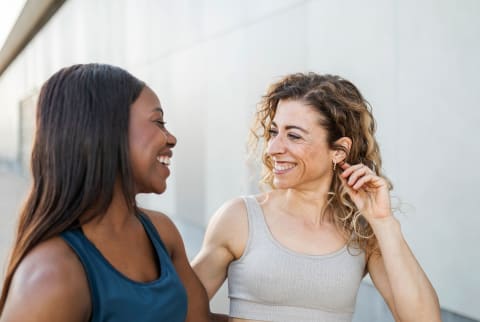If you think you might be bisexual, you might be experiencing a mix of feelings: perhaps confusion, a bit of fear, and maybe, just maybe, a bit of excitement as you’re starting to identify this part of yourself. Ahead, we talk about how to know if you may be bisexual and what to do next if that may be the case. Although the term was traditionally associated with attraction toward men and women, specifically, our understanding of sexual orientation and gender has evolved, and today bisexuality is not boxed as binary. “In the past, we commonly thought of bisexuality as being ‘attracted to both sexes,’ but this more contemporary definition offers and honors gender identity over biological sex and is more inclusive in that way,” Jesse Kahn, LCSW-R, CST, sex therapist and director at the Gender & Sexuality Therapy Center, tells mbg. Bisexuality conforms to no rules when it comes to the type or amount of attraction a person must feel to be considered bisexual. It is not a box to fit into but a doorway to discover one’s authentic self. “Bisexuality can mean attraction to people of your gender and other genders, attraction to multiple genders, and/or being attracted to two or more genders,” Jor-El Caraballo, LMHC, licensed therapist and co-founder of Viva, tells mbg. According to a 2022 Gallup report, 7.1% of U.S. adults identify as LGBTQ+. Of those LGBTQ+ folks, a whopping 57% are bisexual, making it the single largest group within the LGBTQ+ community. “Many people will also define their sense of bisexuality on their own terms as well, so it’s important to be curious about not just what terms people use to identify themselves but also the importance of that identity to them personally,” Caraballo adds. “Ultimately, each person will relate to and define their sexuality differently,” Kahn adds. “It’s about what words mean to you and your communities, and why that word choice is most accurate or meaningful to you.” Here are a few things to keep in mind if you think you may be bisexual: While there may be misconceptions and prejudice surrounding bisexuality, know that it truly is something to celebrate. Your identity is valid, and understanding your sexual preferences better is always a good thing. Keep in mind that you need to open up to people you trust and feel comfortable talking with. Caraballo suggests relying on your more accepting friends and family members, as well as therapists familiar with supporting LGBTQ+ people, for ongoing support in your self-discovery process. This support network can help you process new knowledge and emotions that you are unfamiliar with. It is always easier to work it out with someone else. In all of the confusion, it can be comforting to hear stories from other people’s experiences; knowing that other people may be going through the same things as you are can allow you to gain confidence and find reassurance that everything will be OK. Caraballo also suggests exploring queer books, movies, and other media. However, having to define yourself and identify your preferences need not be rushed. You can take it slow. Explore the idea, see how this label feels, and know that at the end of the day, only you can decide if you are bisexual or not. While labels can provide comfort and validation, your sexual identity is just one part of who you are and one single puzzle piece in the journey to loving yourself better.




